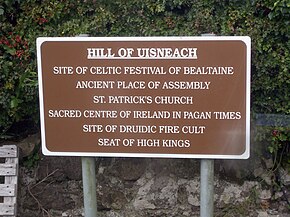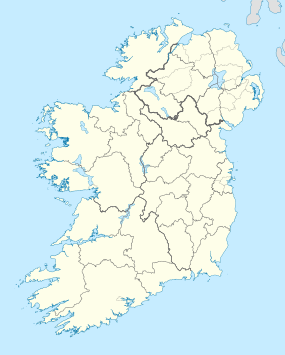Hill of Uisneach
| Irish: Uisneach / Cnoc Uisnigh | |

Information sign
|
|
| Alternate name | Ushnagh (anglicisation) |
|---|---|
| Location | County Westmeath, Ireland |
| Coordinates | 53°29′24″N 7°33′43″W / 53.490°N 7.562°W |
| Type | Ancient ceremonial site |
| Height | 182 metres (597 ft) |
| History | |
| Periods | Iron Age–Middle Ages |
| Cultures | Gaelic |
| Site notes | |
| Public access | Yes |
| Official name | Ushnagh Hill, Catstone |
| Reference no. | 155 |
The Hill of Uisneach or Ushnagh (Irish: Uisneach or Cnoc Uisnigh) is an ancient ceremonial site in the barony of Rathconrath in County Westmeath, Ireland (National Monument Number 155). While it is not the exact geographical centre of Ireland, in Irish mythology it is often considered to be the symbolic center of the land, and is associated with the fire festival of Bealtaine. The hill is 182 metres (597 ft) tall and lies on the north side of the R390 road, 8 km east of the village of Ballymore and beside the village of Loughanavally. The Hill of Uisneach occupies parts of four adjacent townlands: Ushnagh Hill, Mweelra, Rathnew, and Kellybrook.
The site consists of a set of monuments and earthworks spread over two square kilometres. Around and upon the hill are the remains of circular enclosures, barrows, cairns, a holy well and two ancient roads. On the southwest side of the hill is a large, oddly-shaped limestone rock inside a circular enclosure. It is almost 6 metres (20 ft) tall and thought to weigh over 30 tons. In Irish it is called the Ail na Míreann ("stone of the divisions"), as it is said to have been where the borders of the provinces met. It is nicknamed the Cat Stone, allegedly because it resembles the shape of a sitting cat. The biggest enclosure was excavated in the 1920s by R.A.S. Macalister and R. Praeger and showed evidence of occupation from pre-history up to the early Middle Ages.
Based on co-ordinates alone, some believe that it may be the site named as Raiba or Riba by Claudius Ptolemaeus (Ptolemy), the Egyptian-Greek astronomer and cartographer, writing in his Geographia around the year 140 AD.
...
Wikipedia

